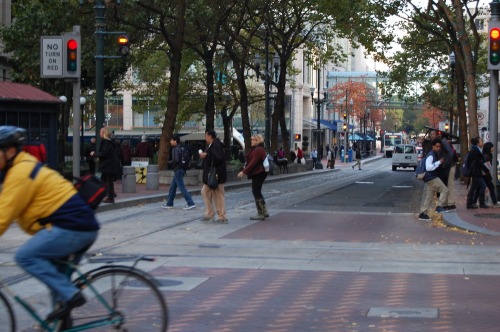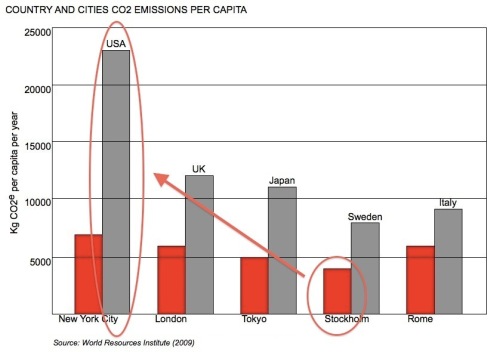The “Jacobs Spillover” as a model of urban dynamics: Can we describe a similar mechanism affecting urban resource use and greenhouse gas emissions?
NOTE: This is a working paper presented at the symposium “Scaling in Cities” at Arizona State University, co-organized with the Santa Fe Institute, University College London and the Environmental Structure Research Group (Sustasis Foundation), in October 2011.
Michael Mehaffy
Among analysts of urban resource use, energy use and greenhouse gas emissions, one rather perplexing and tantalizing phenomenon has been widely recognized. Across the globe, there is an enormous variation in the per-capita rates of consumption, but often without corresponding variations in income, standard of living, or other metrics of “quality of life.” For example, the World Resources Institute (2009) reports a roughly six-fold increase in rates of CO2 emissions per capita, comparing residents of Stockholm, Sweden, to residents of the United States as a whole (including many suburban and rural communities). (FIGURE ONE.) Both populations enjoy a comparably high standard of living that is, if anything, higher in Stockholm by most measurements.
Some of this variation can perhaps be explained by cultural and geographic differences. But it is very hard indeed to explain such a wide variation with such factors alone. In addition, there are great variations even within countries, as the work of McKinsey & Co. (2008) and the World Resources Institute (2009) show. The per-capita rate of CO2 emissions in New York City is roughly one-third of the overall US rate, and the rate in Stockholm is roughly one-half of Sweden’s national rate.
Urban morphologists, intrigued by this data, have looked for variations of morphology that might accont for the variations, such as density, urban distributions, and transportation system variations (e.g. SOLUTIONS research project, 2010). But the magnitudes that are accounted for in these models are generally far lower than the actual variations observed, even when corrected for obvious variables like climate and income. It seems clear that many other factors contribute to the variation, including infrastructure efficiency and personal consumption patterns. Even the identifiable elements, however, seem unable to explain the large magnitude that is observed.
What, then, can account for such a magnitude of variation? It seems that there may be some other kind of mechanism or mechanisms that have not yet been recognized.
The “Jacobs Spillover” and the economic creativity of cities
We suggest that a possible answer may come from the field of economics, and the particular phenomenon known as a “Jacobs Spillover.” Simply put, this is the effect produced by proximities of different businesses, as they invariably exchange knowledge and creative ideas, and the knowledge “spillover” of one enterprise becomes the resource for another. For Jacobs, this was an inherent benefit of cities, and specifically, of the interactions afforded by urban adjacencies.
The Jacobs Spillover is one form of an “externality” – an effect of an economic transaction that is not agreed to by the parties of that transaction, or factored into the accounting of such an economic transaction, but does have a consequence for one or more of the parties, whether positive or negative. An example of a large-scale negative externality is the depletion of resources like oil, or the accumulation of greenhouse gases that cause climate change. These phenomena will eventually impose a real cost, whether or not it is factored into the transactions. (Thus, one promising line of research is in ways to “monetize” these externalities, so that they can provide more direct economic benefits or penalties, and thus work to incentivize the sustainable use of resources.)
But the key observation of interest to us is that the spillover is an output of one system, which becomes an input into another – and this “virtuous circle” has a synergetic effect, increasing the economic efficiency of the city. This seems to be the case particularly when multiple variables are involved, and the synergies can compound through a kind of network effect. For Glaeser et al. (1992, 2009), this synergy from spatial proximity represents a core advantage of cities, and may even explain why cities are economically attractive places at all. This was also a theme of Jacobs’ own book The Economy of Cities (1969).
Nor is the Jacobs Spillover the only such externality that seems to be operating in cities. We may also consider the physical proximity of the consumption of resources, which may account for similar kinds of urban synergies. For example, Stockholm and other cities use “combined heat and power” to utilize the waste heat from power generation to heat homes. Many businesses use the waste output of one process as the input of another – for example, wood manufacturing businesses may use waste wood chips as a fuel source.
Such resource “spillovers” seem to operate in other realms too. If my daily activities are grouped close together, I may use the same trip by streetcar to stop along the way to meet another need that I might otherwise accomplish with a separate trip. These “transit spillovers” might account for a significant part of transit reduction in urban areas, beyond simply reduced distances between destinations.
It seems likely that all of these spillovers might in fact have additional interactive spillover charactertistics – that I might, for example, also find a new job near my home on the way to another destination, and then share a creative bit of knowledge with a colleague, and then perhaps purchase some wood pellets at the local furniture store, and so on. That is, such spillovers might in fact form a kind of “spillover network” that has additional synergies. As this network grows within the city, its capacity to generate additional unforeseen spillovers also grows exponentially with its number of nodes, following the compounding power of networks.
A “Metabolic Network” Model?
A spillover is also an example of a process in which the output of one system becomes the input of another system, which is then able to transform it in some important way. A close analogy is the “metabolic pathways” of biological systems. Such processes typically do not operate in isolation, but as part of complex “metabolic networks.” This allows a complex interactive sequence of processing, with the efficient assembly of very complex outputs as a result.
In ecological systems, we can see a corollary when the excess chemical output or “waste” of one system becomes the input or resource of another. When these processes are part of a larger ecological network, the productivity of the system in biological terms can be greatly accelerated, while the “waste” of the system – the outputs that are not re-used – can be greatly reduced, or even brought to essentially zero. This network of “spillovers” – that is, of outputs becoming inputs – therefore represents a dramatic increase in the “efficiency” of the system – its ability to achieve high states of order with low waste.
Is a similar kind of process perhaps going on in cities? Can we use this model to understand and perhaps enhance the puzzling but remarkable resource efficiency of cities? Can we use it to confront the daunting problem of climate change, and, as suggested by the empirical observaitons, dramatically reduce the emissions of people within cities? This problem takes on special relevance as we see new patterns of urbanization around the globe, and the indications are that these new urban areas will follow the US model of very high consumption of resources with high levels of waste, and very high emissions per capita – a disturbing implication for the prospects of catastrophic climate change.
Topics to investigate
This concept seems to present a number of fruitful lines of investigation.
One revolves around the subject of urban density, or persons per unit of land – a controversial and problematic topic to be sure. Is urban density the only identifiable factor that affects this externality, or can we measure and model other factors? What about certain patterns of spatial distribution – for example, of uses, or of street networks, or of transit modes? What about Jacobs’ own hypothesis that walkable street-based urbanism, with its close stitching of private and public realms, was a critical mode of human connection, not reproduced in other forms of transportation?
There is another interesting question to explore. Why is it that some suburban areas seem to have comparable levels of economic activity from spillovers, without the close proximity of people in cities? Why do they also have high emissions rates, which might suggest here is no correlation with economic spillovers as we suggest here? We hypothesize that this is because they are reproducing the conditions of proximity that facilitate spillover within cities, but doing so artificially, through relatively high-resource consuming activities – particularly, they are driving many trips of long distances in single-occupant automobiles. They are also performing other high-consumption, low-efficiency activities – living in isolated large homes, consuming poor-durability goods, living a “drive-through” lifestyle. They are able to maintain the economic spillovers after a fashion, using automobiles, cell phone contact, email, and other more artificial forms of contact – but only with a lifestyle that requires prodigious (and very likely unsustainable, it appears) inputs of resources.
If this phenomenon can be substantiated, how would a useful model be developed? What would be the metrics, variables, dynamic elements?
Another, more distant but ultimately most important line of inquiry is to explore strategies to exploit this phenomenon, assuming it can be substantiated. Can planners use strategies of “self-organization” to catalyze the spontaneous growth of such urban “metabolic networks”? Can they be facilitated with economic tools, such as pricing signals and other mechanisms? What is the role of “top-down” planning, such as the placement of initial elements of infrastructure and the like? Our hunch is that a mix of all these strategies could be powerful and effective.
This, I suggest, indicates a promising research agenda for further investigation. The tangible goal might be to develop a “spillover network” or “metabolic network” model that might explain some of the more significant synergies and metabolic network-like aspects of urban systems, with the capacity to make differential comparisons based upon morphology. Such a model would ideally be capable of making useful predictions about choices in urban and infrastructure design, and urban and economic policy. Such a model might also facilitate the ability to monetize the currently unpaid costs of unsustainable urban development, and the long-term economic benefits of more sustainable development.
REFERENCES
Glaeser, E. (1992). “Growth in Cities.” Journal of Political Economy, Vol. 100.
Glaeser, E. (2009). “The wealth of cities: Agglomeration economies and spatial equilibrium in the United States.” National Bureau of Economic Research.
Jacobs, J. (1969). The Economy of Cities. New York: Random House.
McKinsey & Company (2009) Pathway to a Low-Carbon Economy : Version 3 of the Global Greenhouse Gas Abatement Cost Curve, p. 7.
SOLUTIONS, Final Report (2010). Accessed September 23, 2011 at http://www.suburbansolutions.ac.uk/Findings.aspx
World Resources Institute (2009) CO2 Emissions per Capita. Accessed September 23, 2011 at http://earthtrends.wri.org/searchable_db/index.php?action=select_countries&theme=3&variable_ID=466



Recent Comments